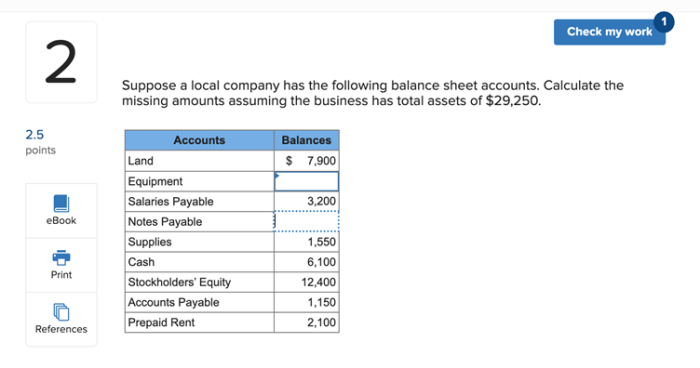Suppose a local company has the following balance sheet accounts: these financial statements provide a comprehensive snapshot of the company’s financial health. This article will delve into the significance of these accounts, categorizing them as current or non-current assets and liabilities.
Moreover, it will explore the concept of owner’s equity and its role in financing a company’s operations. By understanding the balance sheet equation and calculating relevant financial ratios, we can assess the company’s overall financial performance and stability.
Understanding the balance sheet accounts is crucial for various stakeholders, including investors, creditors, and management. These accounts offer valuable insights into the company’s liquidity, solvency, and profitability, enabling informed decision-making and strategic planning.
Balance Sheet Analysis: Understanding Assets, Liabilities, and Owner’s Equity: Suppose A Local Company Has The Following Balance Sheet Accounts

A balance sheet is a financial statement that provides a snapshot of a company’s financial health at a specific point in time. It presents a summary of the company’s assets, liabilities, and owner’s equity.
Assets
Assets are resources owned by a company that have economic value. They are classified as either current or non-current.
| Account Name | Balance | Account Type |
|---|---|---|
| Cash | $100,000 | Current |
| Accounts Receivable | $50,000 | Current |
| Inventory | $75,000 | Current |
| Property, Plant, and Equipment | $200,000 | Non-current |
| Investments | $125,000 | Non-current |
Current assets are those that can be easily converted into cash within one year. Non-current assets are those that are not easily convertible into cash and are typically used in the company’s operations.
The distinction between current and non-current assets is important because it provides insights into a company’s liquidity. Liquidity refers to a company’s ability to meet its short-term obligations. Current assets are more liquid than non-current assets, as they can be more easily used to pay off debts or cover expenses.
Liabilities
Liabilities are debts or obligations that a company owes to others. They are also classified as either current or non-current.
| Account Name | Balance | Account Type |
|---|---|---|
| Accounts Payable | $50,000 | Current |
| Short-Term Debt | $100,000 | Current |
| Long-Term Debt | $200,000 | Non-current |
| Accrued Expenses | $25,000 | Current |
| Deferred Revenue | $50,000 | Non-current |
Current liabilities are those that are due within one year. Non-current liabilities are those that are due after one year.
The distinction between current and non-current liabilities is important because it provides insights into a company’s financial stability. A company with a high proportion of current liabilities may be at risk of default if it is unable to meet its short-term obligations.
Owner’s Equity, Suppose a local company has the following balance sheet accounts
Owner’s equity represents the residual interest in the assets of the company after deducting its liabilities. It is the amount of money that would be returned to the owners if the company were to be liquidated.
- Common Stock
- Retained Earnings
- Treasury Stock
Retained earnings are the cumulative net income of the company that has not been distributed to the owners as dividends. It is an important source of financing for a company’s operations.
Balance Sheet Equation
The balance sheet equation is a fundamental accounting equation that states that the total assets of a company must equal the sum of its liabilities and owner’s equity.
Assets = Liabilities + Owner’s Equity
This equation ensures that the total value of a company’s assets is accounted for and that the company’s financial statements are in balance.
Financial Ratios
Financial ratios are metrics that are used to assess a company’s financial performance and health. They can be calculated using the account balances from the balance sheet.
- Current Ratio
- Debt-to-Equity Ratio
- Return on Equity
These ratios provide insights into a company’s liquidity, solvency, and profitability. They can be used to compare a company to its peers and to track its financial performance over time.
FAQ Insights
What is the importance of categorizing assets as current or non-current?
Categorizing assets as current or non-current is crucial because it provides insights into the company’s liquidity and solvency. Current assets are readily convertible into cash within a year, while non-current assets are not.
How does the balance sheet equation ensure the equality of assets, liabilities, and owner’s equity?
The balance sheet equation (Assets = Liabilities + Owner’s Equity) ensures that the total value of the company’s assets is equal to the sum of its liabilities and owner’s equity. This equation reflects the fundamental accounting principle that every transaction has two sides and maintains the balance of the accounting system.
What is the significance of retained earnings?
Retained earnings represent the portion of a company’s profits that have been reinvested in the business. They are a valuable source of internal financing and indicate the company’s ability to generate and retain earnings over time.


